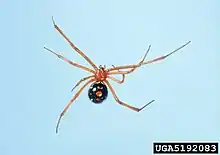| Red widow spider | |
|---|---|
 | |
| Scientific classification | |
| Domain: | Eukaryota |
| Kingdom: | Animalia |
| Phylum: | Arthropoda |
| Subphylum: | Chelicerata |
| Class: | Arachnida |
| Order: | Araneae |
| Infraorder: | Araneomorphae |
| Family: | Theridiidae |
| Genus: | Latrodectus |
| Species: | L. bishopi |
| Binomial name | |
| Latrodectus bishopi Kaston, 1938[1] | |
Latrodectus bishopi is the scientific name for the red widow spider, which is endemic to certain habitats of central and southern Florida, where it lives primarily in sand dunes dominated by sand pine, Pinus clausa – a type of vegetation found only in peninsular Florida.
Description

The red widow, L. bishopi, has a red-orange cephalothorax, its abdomen is black with yellow rings outlining the rows of red spots and its legs are vermillion red. On its underside, it does not have the familiar hourglass marking and instead usually has one or two small red marks.[2] Females are almost double the size of the male.
Taxonomy
The species was first described in 1938 by B. J. Kaston as the variety bishopi of the species Latrodectus mactans.[1][3] The name bishopi honors Marshall B. Bishop who collected the specimens on which the description was based.[3] Latrodectus bishopi was raised to a full species in 1964 by John D. McCrone and Herbert W. Levi.[1] It can be distinguished from L. mactans by features of the male and female genitalia: the embolus of the male palpal bulb has one fewer loop as do the connecting ducts leading to the female spermatheca.[4]
Distribution and Ecology
L. bishopi is endemic to central and southern Florida. It is restricted to sand-pine scrub – inland areas of dry sand dunes dominated by sand pine, Pinus clausa. Within these areas, the species makes most of its webs in palmetto bushes (Serenoa repens and Sabal etonia) at heights of 30 cm or more above the ground.[4] The species is a known predator of Hemisphaerota cyanea.[5]
Toxicity
L. bishopi has been reported to be venomous like the other Latrodectus members,[6] and although no bites by this spider are recorded in the medical literature, a bite has been captured on video and documented by Youtuber MyWildBackyard on April 15, 2023. The bite resulted in a mildly painful throbbing sensation that lasted several hours. Unlike cosmopolitan species such as the black and brown widows, it seldom comes into contact with humans. The median lethal dose (LD50) of the spider's venom has been measured in mice as 2.20 mg/kg (with a confidence interval of 1.29-3.74), and each spider contains about 0.157 mg.[7]
Conservation Status
L. bishopi is a threatened species in the United States.[8]
References
- 1 2 3 "Taxon details Latrodectus bishopi Kaston, 1938". World Spider Catalog. Natural History Museum Bern. Retrieved 2016-01-31.
- ↑ Castner, James. "Black Widow Spider". Featured Creatures. University of Florida. Retrieved 20 September 2018.
- 1 2 Kaston, B.J. (1938). "Notes on a new variety of black widow spider from southern Florida". Florida Entomologist. 21 (4): 60–62. doi:10.2307/3492683.
- 1 2 McCrone, J.D. & Levi, H.W. (1964). "North American widow spiders of the Latrodectus curacaviensis group (Araneae: Theridiidae)". Psyche: A Journal of Entomology. 71: 12–27. doi:10.1155/1964/86469.
- ↑ Carrel, James E.; Deyrup, Mark (March 2014). "Red Widow Spiders (Araneae: Theridiidae) Prey Extensively on Scarab Beetles Endemic in Florida Scrub". Florida Entomologist. 97 (1): 130–137. doi:10.1653/024.097.0155. ISSN 0015-4040. Retrieved 9 November 2022.
- ↑ Hollenbeck, Jeff. "Species Latrodectus bishopi - Red Widow". bugguide. Iowa State University. Retrieved 20 September 2018.
- ↑ McCrone, J.D. (1964). "Comparative lethality of several Latrodectus venoms". Toxicon. 2 (3): 201–203. doi:10.1016/0041-0101(64)90023-6.
- ↑ Skerl, Kevin. "Spider Conservation in the United States". University of Michigan. Retrieved 2017-12-18.